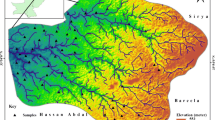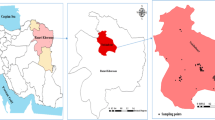Abstract
Health risk caused by the exposure to trace metals in water through different exposure pathways was investigated. Graphite furnace atomic absorption spectrometry was used for the determination of trace metals (nickel, copper, chromium, lead, cobalt, manganese and iron) in drinking water samples. The concentration of metals was compared with the world health organization (WHO) drinking water quality guideline values. Risk of metals on human health was evaluated using Hazard Quotient (HQ). Hazard quotients of all metals through oral ingestion and dermal absorption are found in the range of 1.11 × 10−2 to 1.35 × 10−1 and 8.52 × 10−5 to 9.75 × 10−2, respectively. The results of the present study reflect the unlikely potential for adverse health effects to the inhabitants of Karachi due to the oral ingestion and dermal absorption of water containing these metals.
Similar content being viewed by others
References
ASTM (2000) Standard practice for measuring trace elements in water by graphite furnace atomic absorption spectrophotometry (D 3919-99). Water Environ Technol 11.01
De Miguel E, Iribarren I, Chacon E, Ordonez A, Charlesworth S (2007) Risk-based evaluation of the exposure of children to trace elements in playgrounds in Madrid (Spain). Chemosphere 66:505–513
Hartley WR, Englande AJ, Harrington DJ (1999) Health risk assessment of groundwater contaminated with methyl tertiary butyl ether (MTBE). Water Sci Technol 39:305–310
Kavcar P, Sofuoglu A, Sofuoglu SC (2009) A health risk assessment for exposure to trace metals via drinking water ingestion pathway. Int J Hyg Environ Health 212:216–227
Leung AOW, Duzgoren-Aydin NS, Cheung KC, Wong MH (2008) Heavy metals concentrations of surface dust from e-waste recycling and its human health implications in Southeast China. Environ Sci Technol 42(7):2674–2680
Sun F, Chen J, Tong Q, Zeng S (2007) Integrated risk assessment and screening analysis of drinking water safety of a conventional water supply system. Water Sci Technol 56:47–56
US EPA (1989) Risk assessment guidance for superfund volume I human health evaluation manual (part A)
US EPA (2004) Risk assessment guidance for superfund volume I: human health evaluation manual (part E). http://www.epa.gov/oswer/riskassessment/ragse/pdf/introduction.pdf
Wu B, Zhao DY, Jia HY, Zhang Y, Zhang XX, Cheng SP (2009) Preliminary risk assessment of trace metal pollution in surface water from Yangtze River in Nanjing Section, China. Bull Environ Contam Toxicol 82:405–409
Wu B, Zhang Y, Zhang X, Cheng S (2010) Health risk from exposure of organic pollutants through drinking water consumption in Nanjing, China. Bull Environ Contam Toxicol 84:46–50
Acknowledgments
I am grateful to the Department of Chemistry, University of Karachi for providing all the necessary research facilities.
Author information
Authors and Affiliations
Corresponding author
Rights and permissions
About this article
Cite this article
Karim, Z. Risk Assessment of Dissolved Trace Metals in Drinking Water of Karachi, Pakistan. Bull Environ Contam Toxicol 86, 676–678 (2011). https://doi.org/10.1007/s00128-011-0261-8
Received:
Accepted:
Published:
Issue Date:
DOI: https://doi.org/10.1007/s00128-011-0261-8




